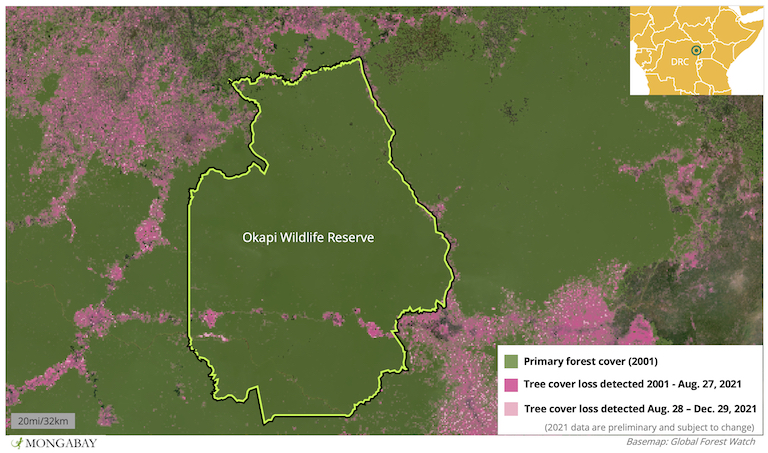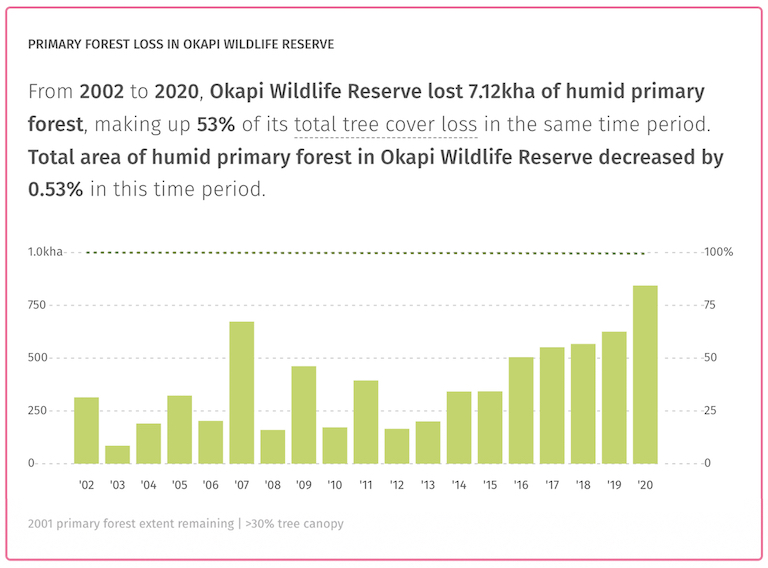
- Okapi Wildlife Reserve in the Democratic Republic of the Congo (DRC) shelters some 470 mammal and bird species, including up to 20% of the world’s remaining endangered okapi (Okapia johnstoni), which are related to giraffes.
- While Okapi Wildlife Reserve has escaped much of the environmental destruction affecting surrounding areas, satellite data show deforestation has been increasing in the reserve in recent years.
- Satellite imagery shows the expansion of what appear to be gold mines in the latter half of 2021.
- Conservationists say illegal mining is attracting more people to the reserve, which in turn increases poaching and deforestation.
Perched in northeastern Democratic Republic of Congo (DRC) near the borders of Uganda and South Sudan, Okapi Wildlife Reserve quietly encompasses some 14,000 square kilometers (5,405 square miles) of rainforest habitat. The DRC government established the reserve in 1996, and it is also recognized by the United Nations Education, Scientific and Cultural Organization (UNESCO) as a World Heritage Site due to its diverse plant and animal species, some of which are found nowhere else except for in this region of the DRC.
Okapi Wildlife Reserve protects more than 100 mammal and 370 bird species, including 17 known species of primates – more than any other single forested area in Africa. The reserve is also home to the Indigenous Efe and Mbuti peoples.
But perhaps the reserve’s most famous resident is the enigmatic okapi (Okapia johnstoni), after which it was named. Sporting the head of a giraffe and the stripes of a zebra, the okapi was unknown to the scientific world till the 20th century and is found only in the northeastern portion of the DRC. Also known as the “African unicorn” of forest giraffe, the species is listed as endangered by the IUCN, and Okapi Wildlife Reserve harbors as many as 20% of the estimated 30,000 remaining wild okapi.

The reserve also contains about one-fifth of the Ituri Rainforest, an ecosystem that has changed little over the past 11,000 years to the extent that ecologists consider it a “Pleistocene refugium” where species have survived glacial periods – in effect a portal back in time to the last epoch.
But the Ituri Rainforest, immutable over millennia, is coming under increasing threat from human pressure. According to satellite data from the University of Maryland visualized on Global Forest Watch, the Ituri province of DRC lost nearly 7% of its primary forest cover between 2002 and 2020. The rate of deforestation in the province appears to be rising, with the majority of primary forest loss (nearly 60%) occurring in the five years between 2016 and 2020.

Aided by its gauntlet of protections and remote location, Okapi Wildlife Reserve has escaped the deforestation faced by the rest of Ituri province, at least comparatively. But human pressure is still affecting the reserve, and that pressure appears to be increasing.
In 1997, a year after Okapi Wildlife Reserve was formally established, UNESCO added it to its List of World Heritage in Danger due to poaching, mining and the looting of park facilities. Okapi Wildlife Reserve is one of only four such sites in the DRC, along with national parks Virunga, Garamba and Kahuzi-Biega.
The situation appears to have deteriorated in the intervening quarter-century. In 2012, poachers murdered seven people in Okapi Wildlife Reserve, including two forest guards, and shot dead more than a dozen captive okapis. The forest guards were employed by the Congolese Institute for the Conservation of Nature (ICCN) which, together with Wildlife Conservation Society and Okapi Conservation Project, manage monitoring and protection activities in the reserve.

In 2020, another ICCN forest guard was reportedly killed in the line of duty.
“I am deeply concerned at the upsurge of violence at the World Heritage sites in the Democratic Republic of the Congo, and I want to pay special tribute to the immense courage of the guards that ensure the protection of World Heritage sites in what can be extremely difficult and dangerous situations,” said UNESCO Director-General Audrey Azoulay in an undated press release, “We remain deeply concerned by the threats against the ICCN staff and their families at the Okapi Wildlife Reserve.”
In addition to security threats, satellite data from the University of Maryland visualized on Global Forest Watch show increasing levels of forest loss in the reserve, with more deforestation recorded in 2020 than in any previous year since measurement began in 2002. Preliminary data for 2021 suggest forest loss tapered around 4% last year, but still amounted to the second-highest level of deforestation in the reserve since 2002.


Satellite imagery from Planet Labs shows that much of the deforestation in Okapi Wildlife Reserve that happened in the latter half of 2021 occurred along the Ituri River and bears the hallmarks of gold mining. In June 2021, Reuters reported the seizure of 31 kilograms of gold worth around $1.9 million that had been mined in the reserve.
“Not only are these people mining gold, they are also melting it,” Lieutenant Jean de Dieu Musongela, head of the military prosecutor’s office in Mambasa, told Reuters in 2021.
Gold mining – particularly informal, unregulated, illegal gold mining – is associated with a gamut of environmental problems, from forest loss and poaching to the release of toxic substances into waterways. Mercury, a neurotoxin, is often used to extract gold ore from sediment, and easily escapes into water sources where it magnifies up the food chain and poses dangers to fish-dependent wildlife and human communities.

Conservationists are concerned that as mining activity increases in Okapis Wildlife Reserve, other destructive practices will too.
“Mines draw in desperate people, depend on bush meat to feed the miners and are subject to extortion by rogue militias and the military,” John Lukas, co-founder of the Okapi Conservation Project, told Mongabay in 2019. “Secondly, clearing of forest by immigrants is an increasing threat along with logging in certain areas.”
Banner image of an okapi by Steve Wilson via Wikimedia Commons (CC BY-SA 2.0).
Editor’s note: This story was powered by Places to Watch, a Global Forest Watch (GFW) initiative designed to quickly identify concerning forest loss around the world and catalyze further investigation of these areas. Places to Watch draws on a combination of near-real-time satellite data, automated algorithms and field intelligence to identify new areas on a monthly basis. In partnership with Mongabay, GFW is supporting data-driven journalism by providing data and maps generated by Places to Watch. Mongabay maintains complete editorial independence over the stories reported using this data.
Feedback: Use this form to send a message to the editor of this post. If you want to post a public comment, you can do that at the bottom of the page.
Refuge of endangered ‘African unicorn’ threatened by mining, poaching, deforestation
Source: Trends News

0 Comments